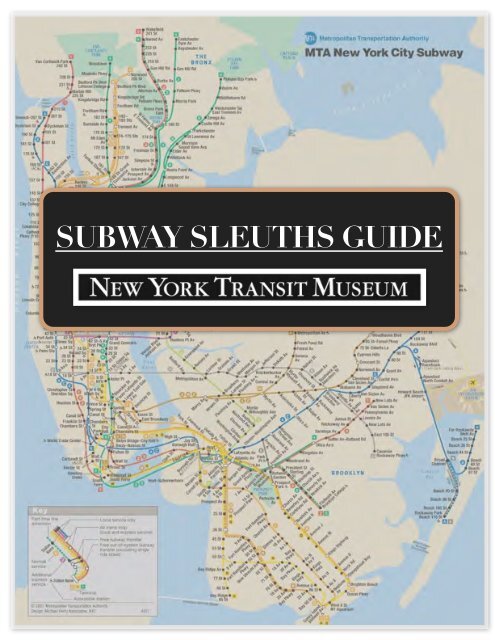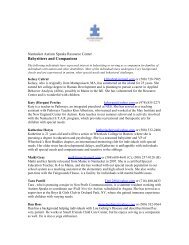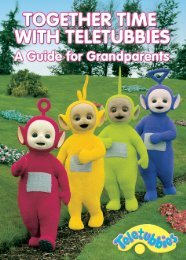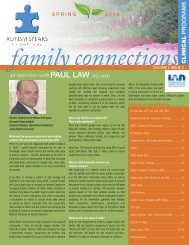Subway Sleuths Program Guide - Autism Speaks
Subway Sleuths Program Guide - Autism Speaks
Subway Sleuths Program Guide - Autism Speaks
Create successful ePaper yourself
Turn your PDF publications into a flip-book with our unique Google optimized e-Paper software.
SUBWAY SLEUTHS GUIDE
This guide serves to illustrate the power that special interest<br />
areas (SIA) of children with autism can bring to educational<br />
programs and how these interests can both motivate and<br />
support students’ social engagement. This guide presents how<br />
the New York Transit Museum has harnessed this power and<br />
encourages other museums and after-school programs to<br />
consider how they, too, could incorporate the principles of the<br />
<strong>Subway</strong> <strong>Sleuths</strong> program.<br />
New York Transit Museum<br />
<strong>Subway</strong> <strong>Sleuths</strong> <strong>Guide</strong>, 2012<br />
Developed by Susan Brennan, CCC-SLP and Lauren Hough, MSEd
Table of Contents “This was my son’s first<br />
๏ GOAL OF THE GUIDE<br />
๏ INTRODUCTION TO SLEUTHS<br />
๏ HISTORY & PHILOSOPHY<br />
๏ PROGRAM BASICS<br />
๏ SESSIONS<br />
after-school program, and I<br />
am happy it was such a<br />
positive experience for him!<br />
He loves trains and the<br />
<strong>Sleuths</strong> helped him feel more<br />
comfortable with his peers.<br />
He can now join other<br />
programs with confidence. “<br />
- Mom of <strong>Subway</strong> Sleuth<br />
๏<br />
๏<br />
๏<br />
๏<br />
๏<br />
Lesson plans<br />
Structure, supports, & strategies<br />
Note-taking sheets<br />
Parent communication<br />
Positive impact<br />
๏<br />
GALLERY
The goal of the <strong>Subway</strong> <strong>Sleuths</strong> is to honor<br />
strengths of students on the autism spectrum<br />
and tap into a shared interest to add feelings<br />
of comfort, competence and excitement to<br />
social interactions. This guide aims to inspire<br />
the development of similar strength-based<br />
programs for other students with autism.<br />
At the New York Transit Museum, our <strong>Sleuths</strong> get to engage in an<br />
environment in which they are passionate and where they are the experts.<br />
People are drawn to others who share their passions. Individuals with autism<br />
are no different. This shared interest can be a foundation for investigating<br />
social interactions.<br />
While children with autism often have challenges in pragmatic language,<br />
social communication, reading others’ emotions, and processing sensory<br />
input, studies have found that these deficits diminish when participants are<br />
engaged in their special interest areas 1 .<br />
Because trains are a popular SIA of individuals with autism, the New<br />
York Transit Museum is perfect for this type of work. The museum itself serves<br />
as both the motivator and the organizational structure for highlighting,<br />
modeling, investigating and experiencing social interactions. For The <strong>Subway</strong><br />
<strong>Sleuths</strong>, it’s all about trains and transportation! And, once we embrace the<br />
idea that children can be experts in the things that interest them and that the<br />
feeling of competence this yields is the place to start social learning, the<br />
possibilities are endless.<br />
We invite you take a short tour on our <strong>Subway</strong> <strong>Sleuths</strong> train.<br />
We will give you an overview of our environment and one special interest<br />
area that we hope will inspire and lead to the use and celebration of<br />
many many more.<br />
1 Winter-Messiers, M. A. (2007). From Tarantulas to Toilet Brushes: Understanding the Special Interest Areas of Children and<br />
Youth With Asperger Syndrome. Remedial and Special Education, 28 (3), 140-152
The New York Transit Museum’s <strong>Subway</strong> <strong>Sleuths</strong> is an after-school program<br />
designed for train enthusiasts on the autism spectrum. Groups are facilitated by an<br />
experienced special educator and speech-language pathologist trained in supporting with<br />
students with autism spectrum disorders, who work in collaboration with museum<br />
educators from the Transit Museum. A core goal of this program is to capitalize on<br />
students’ authentic interests in the transit system to help them navigate shared social<br />
experiences with their peers. Anchored in Self-Determination Theory and promising<br />
practices in the field of ASD, the program facilitators utilize social-pragmatic language and<br />
social cognitive strategies to target four specific goal areas. During the 10-week program,<br />
the facilitators use strategies within an interest-based framework to encourage students’<br />
enthusiasm for the transit system and also to address areas of difficulty common for<br />
students on the autism spectrum.
History & Philosophy<br />
The New York Transit Museum, one of the city's leading cultural<br />
institutions, is the largest museum in the United States devoted to urban public<br />
transportation history, and one of the premier institutions of its kind in the world.<br />
The Museum explores the development of the greater New York Metropolitan<br />
region through the presentations of exhibitions, tours, educational programs, and<br />
workshops dealing with the cultural, social, and technological history of public<br />
transportation. Since it's inception over a quarter century ago, the Museum,<br />
housed in a historic 1936 IND subway station in Brooklyn Heights, has grown in<br />
scope and popularity. As custodian and interpreter of the region's extensive public<br />
transportation networks, the Museum strives to share, through its public programs,<br />
this rich and vibrant history with local, regional, and international audiences.<br />
For more information, please visit the New York Transit Museum at<br />
www.mta.info/mta/museum/<br />
The New York <strong>Subway</strong> <strong>Sleuths</strong> program is an after-school program with a<br />
therapeutic lens that is designed for train enthusiasts on the autism spectrum.<br />
<strong>Sleuths</strong> capitalizes on its students genuine and authentic interests and uses them<br />
as a base for encouraging social development. Sessions focus on encouraging<br />
natural engagement through participants’ motivation to share their interest in trains<br />
with others. The Transit Museum and its content is used as a platform for<br />
investigating the social. Support is provided so that students on the spectrum are<br />
able to share their love an knowledge of the transit system with peers, and giving<br />
them access to participating in an after-school experience tailored to their interests<br />
and needs.
<strong>Program</strong> Basics<br />
1<br />
2<br />
3<br />
4<br />
5<br />
6<br />
STAFFING: The <strong>Subway</strong> Sleuth groups are facilitated by a speechlanguage<br />
pathologist and a special educator with training and<br />
experience working in the field of ASD. Sessions are also supported by<br />
Transit Museum staff who share their expertise in the museum content.<br />
OUTREACH & SCREENING: Information about the groups are<br />
distributed to schools, posted on blogs, and advertised on the museum<br />
website. Interested students are screened by autism consultants and<br />
group facilitators to determine program and group compatibility.<br />
SESSIONS: The <strong>Sleuths</strong> program consists of 10, 1 hr. 15 min. goaldirected<br />
sessions that utilize the Transit Museum as a classroom.<br />
Groups are made up of 5 to 7 train enthusiasts on the autism spectrum<br />
who work together, ultimately producing a culminating project.<br />
CONSULTATION: <strong>Sleuths</strong> groups are supported by experienced<br />
consultants who specialize in autism spectrum disorders. Consultants<br />
conduct mid- and post-session observations to support facilitators and<br />
help to guide note-taking and goal-tracking procedures.<br />
PARENT COMMUNICATION: Newsletters highlighting pictures,<br />
projects, and sleuth vocabulary are sent out at the mid-point of the<br />
sessions as well as at the close of the 10 weeks. These newsletter<br />
share groups’ main goals and key concepts with Sleuth families and<br />
also invite parents to the <strong>Sleuths</strong>‘ end of session project presentation.<br />
FUTURE PLANNING: As the <strong>Subway</strong> Sleuth program continues to<br />
grow, the Transit Museum is exploring ways to expand the number of<br />
groups offered, to standardize the program, to explore options to track<br />
its success, and to provide training for new facilitators.
Sleuth Strategies<br />
1. Structure sessions with visuals such as a schedule<br />
Example: Sleuth schedule<br />
Why: To capitalize on visual strengths, to<br />
organize the session time for students, to<br />
provide a visual to support shared<br />
memory recall, and to promote shared<br />
thinking<br />
2. Structure dyad work relating to the larger group activity<br />
Example: Break up into dyads to do<br />
part of a project for the whole group<br />
Why: To support gestalt processing<br />
and flexibility, to consider various<br />
social regulation strengths/challenges<br />
3. Build and utilize shared memories<br />
Example: Taking and reviewing pictures<br />
and labeling shared moments<br />
Why: To build self-awareness and<br />
connectedness (use of shared memory to<br />
relate/connect to others), to support<br />
emotional memory recall (episodic<br />
memory)
Sleuth Strategies<br />
4. Model shared language rooted in social concepts 2<br />
Example: "Solo-car” / “Six-car train” for “out of the<br />
group” / “part of the group” and "runaway train thought"<br />
for topic changes<br />
Why: To build social concepts through motivating area of<br />
interest, to build connections and social self-awareness,<br />
to use language specific to the group and to capitalize<br />
on shared dynamic thinking for concept building<br />
Whoa!<br />
That was a<br />
‘six-car train<br />
thought’! Nice<br />
group<br />
thinking.<br />
5. Use of roles to collaborate & understand place in a group<br />
Example: “We’ll be the Z-line logo<br />
designers to help the map cartographers<br />
and train engineers with the group project.”<br />
Why: To support understanding one’s place<br />
in a group, maintain interactions, consider<br />
self as part of a whole (facilitated by<br />
assigning roles, start in dyads), support<br />
appraisal of group work<br />
6. Reflect as a group and provide feedback to every student<br />
Example: “When you added your ‘Z-train’ idea to the other group’s ‘Whiteline’<br />
idea you connected your thoughts and kept our six-car train running!<br />
Nice sharing your thinking. Great teamwork.”<br />
Why: To provide labels and summaries of social concepts in action,<br />
highlighting their active use to lock-in understanding and encourage<br />
generalization<br />
2<br />
Such as concepts from Michelle Garcia Winner’s Social Thinking paradigm
Sessions<br />
Each session is designed by the facilitators to meet the<br />
needs of the students in that group.<br />
Lesson plans includes the following components:<br />
1. Overall goals<br />
2. Learning and social<br />
objectives<br />
3. Materials (e.g., cameras,<br />
projectors, materials to<br />
create visuals)<br />
4. Procedures for session activities<br />
5. Notes for future sessions
<strong>Subway</strong> <strong>Sleuths</strong> SAMPLE Lesson Plan<br />
Tuesdays Fall 2012<br />
Session 3<br />
Overall Goals: Overall group goals targeted across multiple sessions<br />
• To build the concepts of:<br />
o<br />
o<br />
o<br />
being part of a group and working as a group<br />
using flexible thinking to help the group<br />
learning new information and sharing what you know about the transit<br />
system<br />
Learning & Social Objectives: Focused goals for this session<br />
o<br />
o<br />
o<br />
o<br />
o<br />
To follow a session structure (using visual train schedule)<br />
To share space and experiences with adults and peers<br />
To explore the idea of “the group” in different configurations<br />
To accept and assign roles in a larger group and dyad<br />
To collaborate and apply train knowledge to solve riddles<br />
Materials: Materials to support the session’s activities in the museum<br />
o<br />
o<br />
o<br />
o<br />
o<br />
o<br />
o<br />
Train schedule visual<br />
Name-tag buttons<br />
(5) full-size images and (3) reprints of those images from last session<br />
Digital camera<br />
<strong>Subway</strong> maps and books<br />
(3) sets of (4) riddles<br />
Museum materials: Keys and locks
Procedures: Activities and strategies used to target goals and build concepts<br />
1) “All Aboard” / Warm-up (4:15 – 4:45)<br />
• “Waiting time” spent in the location: On the Streets [-4:25]<br />
o During waiting time, take restroom breaks<br />
• “Exploration time” with subway maps / books [-4:35]<br />
o Spread out maps and books- encourage independent exploration<br />
-‐ Use declarative language to encourage communication<br />
• “Super <strong>Subway</strong> Sleuth Train” [-4:50]<br />
o Spread out materials across more tables<br />
o Show group images – draw out memories of names<br />
-‐ “What were we doing?,” humorous moments, “label the moment”<br />
o Model assigning/accepting roles with the limited tools (i.e. one pair scissors,<br />
one glue stick, etc.)<br />
2) Next Stop (4:45– 5:15)<br />
• “Mystery of the Missing Keys”<br />
o Introduce activity: Introduce pretend scenario-“We have a problem! We had<br />
a special train treat for you guys, but Virgil locked it in his locker. He went to<br />
go look for his keys and now they are missing! Someone left a note that<br />
says, ‘Ha-ha I played a trick on you! Good luck finding those keys!’ We<br />
have a train mystery to solve, <strong>Sleuths</strong>!”<br />
o Each dyad gets 1 set of 4 train museum riddles to solve together<br />
o Teams work together to solve each riddle, which will take them to a different<br />
place in the museum. The final location contains a note saying “These<br />
letters are a clue! Bring them back to the station to work with group to solve<br />
the mystery!”<br />
o Each group brings back a set of letters spelling ___________? The whole<br />
group puts the letters together to find the “key word”.<br />
o “Key word” tells the group the location of the keys. The group gets the keys<br />
and brings them to the locker to get the special <strong>Sleuths</strong> treat.<br />
o Celebrate!<br />
3) Last Stop (5:15 – 5:30)<br />
• “Wrap-Up/Reflection”<br />
o Discuss experiences from the session and highlight teamwork behaviors<br />
o Provide constructive reflection<br />
o Discuss what helped keep the group together during the session<br />
o Celebrate and build anticipation for next session
Notetaking<br />
Group facilitators take notes following each session to document how the session<br />
went and to record individual student present functioning. Overall impressions are<br />
recorded, and facilitators discuss students‘ social engagement, problem solving,<br />
pragmatic language, social cognition, flexibility, and self-regulation.<br />
Abridged Notetaking Sheet<br />
Student name(s): ______________________________________________________________<br />
Date: ____________!<br />
Notes below for: ❒ Student/session observation ❒ Session/activity planning ❒ Other: __________________________<br />
Social Engagement<br />
For example...<br />
❒ Makes connections with others around train experiences<br />
❒ Checks to see if partner agrees with an idea<br />
❒ Accept roles to further a group goal<br />
Problem solving<br />
For example...<br />
❒ Recognize a problem, determine cause<br />
❒ Recognize known versus unknown information<br />
❒ Makes predictions and provides solutions<br />
Pragmatic Language<br />
For example...<br />
❒ Read nonverbal cues of others<br />
❒ Assert in interaction without dominating<br />
❒ Ask/answer questions<br />
Social Cognition<br />
For example...<br />
❒ Think about and recognize another’s interest<br />
❒ Recognize shared interest- basis for social interaction<br />
❒ Consider partner’s perspective/compromise<br />
Flexibility<br />
For example...<br />
❒ Demonstrate flexibility during change in schedule<br />
❒ Recognizing and following someone else’s plan<br />
❒ Compromise for the sake of the group<br />
Self-Regulation<br />
For example...<br />
❒ Coordinate actions with a partner<br />
❒ Cope with challenging situations by asking for help<br />
❒ Transition between different activities
Positive Impact<br />
The Transit Museum is committed to tracking the positive impact of the<br />
<strong>Subway</strong> <strong>Sleuths</strong> program on its participants. Capitalizing on the students’<br />
interest in trains and their motivation to explore this content, we create a place<br />
for shared learning and imagination where students with autism can explore the<br />
Social World.<br />
It is our vision that the <strong>Subway</strong> <strong>Sleuths</strong><br />
program will give participants a unique<br />
opportunity to access the social experience of<br />
working with peers around an area of<br />
competence, and that we will able to see the<br />
positive impact of this experience.<br />
Even across a limited number of sessions, we hope to give our <strong>Sleuths</strong> the<br />
opportunities and supports to learn new information on a subject of interest<br />
while exploring new ways of engaging with peers. We hope to tap into our<br />
students’ motivation to reach out to their peers as they interact around a mutual<br />
interest within the walls of the Transit Museum. In this environment, we hope to<br />
see an increase in students’ social engagement that can be documented across<br />
the 10-week sessions using a Progress Tracking Sheet.<br />
Ultimately, we hope to see the <strong>Subway</strong> Sleuth’s social concepts extending<br />
to experiences outside of the museum. Parent pre and post-session<br />
questionnaires are used to collect feedback, helping us note students’ use of<br />
concepts in other environments and also helping us determine parent<br />
perspectives on the success of an after-school program tailored specifically for<br />
their children with autism. These tools are used to not only document the<br />
positive impact of <strong>Sleuths</strong>’ train enthusiasts, but also to help to continually guide<br />
improvements to the program from group to group.
Positive Impact: Sample Tools<br />
Sample from Progress Tracking Sheet:<br />
How often does the child...<br />
Might look/sound<br />
like...<br />
BASELINE<br />
After Session 2<br />
FINAL<br />
After Session 9<br />
Use verbal and nonverbal<br />
language to make connections<br />
with another in the moment?<br />
- Pointing to establish Dyad:<br />
Dyad:<br />
joint attention in an<br />
interaction. Group: Group:<br />
Use verbal and/or nonverbal<br />
language to demonstrate<br />
memory of shared experiences?<br />
- Referencing memories<br />
with, “I remember when<br />
we...”<br />
Dyad:<br />
Group:<br />
Dyad:<br />
Group:<br />
Use roles to collaborate?<br />
Demonstrate an interest in being<br />
part of the group?<br />
- “I’ll be conductor, you<br />
can be the mapper.”<br />
Dyad:<br />
Group:<br />
Dyad:<br />
Group:<br />
- Staying physically with Dyad:<br />
Dyad:<br />
the group to work on a<br />
shared project. Group: Group:<br />
Sample Questions from Parent Survey:<br />
Does your child make comments on their own to you/to others when engaged in an<br />
activity he/she enjoys (e.g. “I love coloring!” or “My train is going faster than your<br />
train”, “This is awesome!”, give a high five)?<br />
Does your child ever talk about an experience he/she remembers having with you (e.g.,<br />
“Remember when we went to Coney Island that time last summer? That was fun!”)?<br />
Does your child ever change what he/she is doing or invite another into their game<br />
when playing with another person so that the play can continue (e.g., “Oh, you’re<br />
putting the tracks together? Ok, then I’ll start working on the bridges.” or “I’m<br />
building the space ship. You can put the people together!”)?<br />
When your child is in an interaction with another person, does he/she ever tell them<br />
his/her ‘plan’ before leaving for a short period of time (e.g., “I’m just going to go get<br />
us some glue!” or “I’ll be back- I just have to go wash my hands.”)?
In the <strong>Subway</strong> <strong>Sleuths</strong>, train<br />
enthusiasts share thinking, stay<br />
connected, explore together, and<br />
talk about trains to their<br />
hearts’desires!
Our Ultimate<br />
Social World<br />
Classroom!<br />
Contact us for more information!<br />
Marcia Ely, Assistant Director<br />
New York Transit Museum<br />
marcia.ely@nyct.com<br />
Susan Brennan CCC-SLP & Lauren Hough MSEd<br />
The Social Underground<br />
info@thesocialunderground.org
We hope that this guide has served both to introduce the mission of the<br />
New York Transit Museum’s <strong>Subway</strong> <strong>Sleuths</strong> program and also to inspire<br />
others to consider the possibilities for their own museums and after-school<br />
programs. Strength-based programming has tapped into the natural<br />
curiosity and enthusiasm of our train enthusiasts, and has given them a<br />
place to explore the social world while also sharing with us their strengths,<br />
talents, and passions.<br />
The authors of this publication hereby acknowledge <strong>Autism</strong> <strong>Speaks</strong> Family<br />
Community Grants as the funding agency for the project leading to this<br />
publication. The views expressed in this publication do not necessarily<br />
express or reflect the views of <strong>Autism</strong> <strong>Speaks</strong> or any other funding agency.






